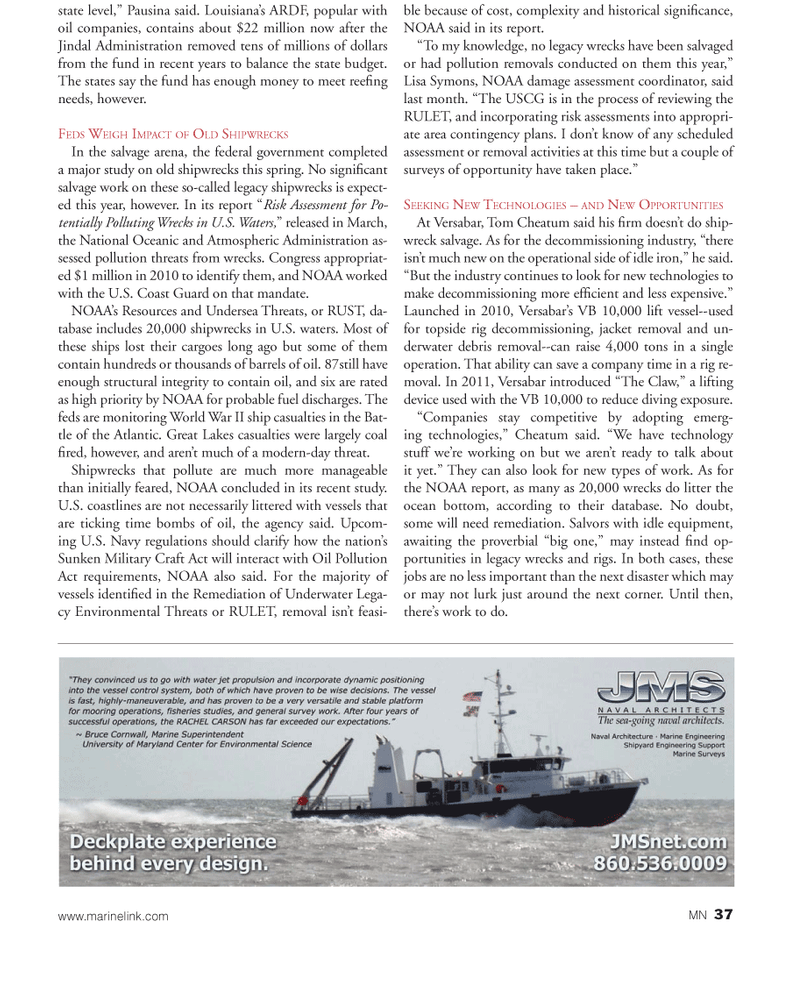
Page 37: of Marine News Magazine (August 2013)
Salvage & Response
Read this page in Pdf, Flash or Html5 edition of August 2013 Marine News Magazine
state level,? Pausina said. Louisianas ARDF, popular with oil companies, contains about $22 million now after the Jindal Administration removed tens of millions of dollars from the fund in recent years to balance the state budget. The states say the fund has enough money to meet ree? ng needs, however. FEDS WEIGH IMPACT OF OLD SHIPWRECKS In the salvage arena, the federal government completed a major study on old shipwrecks this spring. No signi? cant salvage work on these so-called legacy shipwrecks is expect- ed this year, however. In its report Risk Assessment for Po- tentially Polluting Wrecks in U.S. Waters, ? released in March, the National Oceanic and Atmospheric Administration as- sessed pollution threats from wrecks. Congress appropriat- ed $1 million in 2010 to identify them, and NOAA worked with the U.S. Coast Guard on that mandate. NOAAs Resources and Undersea Threats, or RUST, da- tabase includes 20,000 shipwrecks in U.S. waters. Most of these ships lost their cargoes long ago but some of them contain hundreds or thousands of barrels of oil. 87still have enough structural integrity to contain oil, and six are rated as high priority by NOAA for probable fuel discharges. The feds are monitoring World War II ship casualties in the Bat- tle of the Atlantic. Great Lakes casualties were largely coal ? red, however, and arent much of a modern-day threat. Shipwrecks that pollute are much more manageable than initially feared, NOAA concluded in its recent study. U.S. coastlines are not necessarily littered with vessels that are ticking time bombs of oil, the agency said. Upcom- ing U.S. Navy regulations should clarify how the nations Sunken Military Craft Act will interact with Oil Pollution Act requirements, NOAA also said. For the majority of vessels identi? ed in the Remediation of Underwater Lega- cy Environmental Threats or RULET, removal isnt feasi- ble because of cost, complexity and historical signi? cance, NOAA said in its report. To my knowledge, no legacy wrecks have been salvaged or had pollution removals conducted on them this year,? Lisa Symons, NOAA damage assessment coordinator, said last month. The USCG is in the process of reviewing the RULET, and incorporating risk assessments into appropri- ate area contingency plans. I dont know of any scheduled assessment or removal activities at this time but a couple of surveys of opportunity have taken place.? SEEKING NEW TECHNOLOGIES ? AND NEW OPPORTUNITIES At Versabar, Tom Cheatum said his ? rm doesnt do ship- wreck salvage. As for the decommissioning industry, there isnt much new on the operational side of idle iron,? he said. But the industry continues to look for new technologies to make decommissioning more ef? cient and less expensive.? Launched in 2010, Versabars VB 10,000 lift vessel--used for topside rig decommissioning, jacket removal and un- derwater debris removal--can raise 4,000 tons in a single operation. That ability can save a company time in a rig re- moval. In 2011, Versabar introduced The Claw,? a lifting device used with the VB 10,000 to reduce diving exposure. Companies stay competitive by adopting emerg- ing technologies,? Cheatum said. We have technology stuff were working on but we arent ready to talk about it yet.? They can also look for new types of work. As for the NOAA report, as many as 20,000 wrecks do litter the ocean bottom, according to their database. No doubt, some will need remediation. Salvors with idle equipment, awaiting the proverbial big one,? may instead ? nd op- portunities in legacy wrecks and rigs. In both cases, these jobs are no less important than the next disaster which may or may not lurk just around the next corner. Until then, theres work to do. www.marinelink.com MN 37MN August2013 Layout 32-49.indd 377/23/2013 7:25:41 PM

 36
36

 38
38
